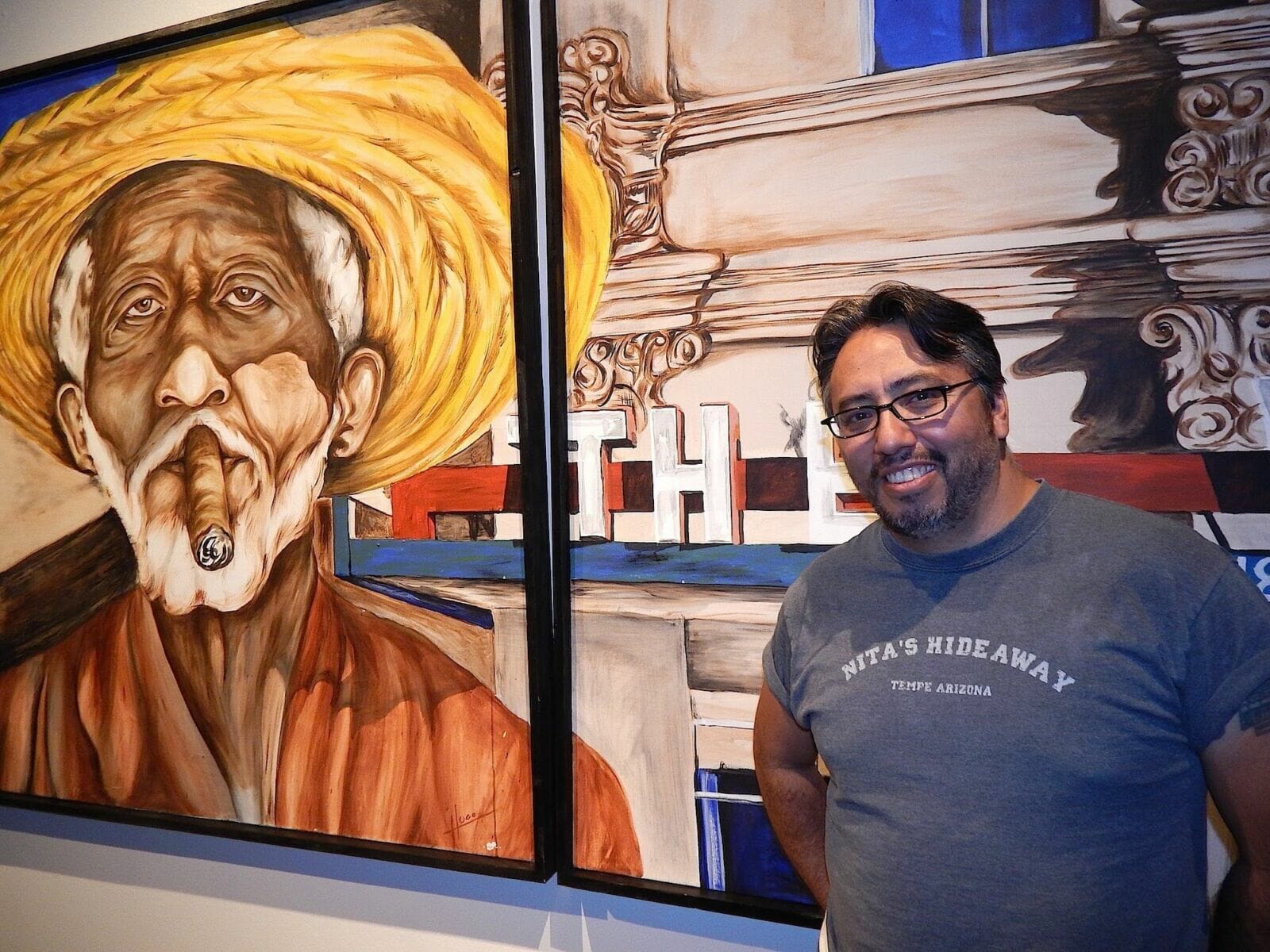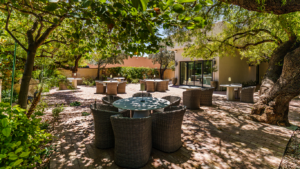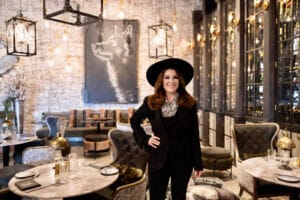The area surrounding Guerrero Rotary Park in Mesa has a long and storied history. Since the early 1900s, the neighborhood has been home to a large Mexican American population that brought its culture and traditions to the region. The area counts among its famous residents Rosaura and Pedro W. Guerrero, founders of Rosarita Mexican food products, as well as their son Pedro E. Guerrero, the renowned photographer best known for his work with Frank Lloyd Wright. To this day, the park and neighborhood bear the family name.
Over the years, policies that diverted investment away from minority neighborhoods created economic disparities in areas such as Guerrero Park, and the eponymous park, a centerpiece of the community, was no longer filled with happy children because of increased criminal activity and people experiencing homelessness. The neighborhood grew from its rich cultural roots and was also a popular spot for street art. Faded paintings that showcased the tight-knit community’s Hispanic roots covered walls and spoke of a collective history and bond that had connected neighbors for more than a century.
READ ALSO: 15 Arizona murals that are Instagrammable
“There are neighborhoods that some people say are going downhill and need revitalization and love, when the reality is that they already have an authentic sense of place and a lot of core community uses,” explains Trevor Barger, CEO of Espiritu Loci and principal at Arizona Strategies. “There’s usually a great church, a community center of some sort, a school — and none of those are failing. The community is pretty well connected. The people may be internally focused, but they know who each other are and what their past has been, and most of them have lived in the area for quite a while. These aren’t areas that need to be torn down and rebuilt. They’re areas that already have strong connections but oftentimes don’t have a way to express in physical form what has been created.”
The Guerrero Park neighborhood is one such example. In a unique collaborative partnership with the community and the City of Mesa, ULI Arizona’s community mural project, known as ULI2D and chaired by Barger, married the talents of ULI and local artists with a master-planned public art installation.
ULI’s mission is to shape the built environment for transformative impact in communities, and a key focus area is creative placemaking/keeping, leveraging art and creativity to strengthen spaces and places.
“When you talk about social indicators of public health, one is the walkable distance from your home to a park,” says Mesa Mayor John Giles. “But having a park that is a walkable distance to your house that you never walk to doesn’t work, does it? This project in Guerrero Park is important. It created vibrant places that residents walk to and enjoy, where they have social interaction with their neighbors, and where kids play and get in some exercise because the park is a much more interesting experience.”
He adds, “If you drive by the park today, the vibe is different and the environment is healthier than it was before.”

But convening a public art project requires more than simply putting paint brushes to walls.
Patrice Marcolla, vice chair of the ULI2D committee, explains. “There’s a level of trust and credibility that needs to be built,” she says. “When you look at a neighborhood from the outside, you don’t really know or understand it’s history. We want to develop a true understanding, and that only comes with time and engagement.”
The team spent months working with community members and neighborhood leaders, going door to door and listening to what residents were proud of, what they aspired to and what they wanted, and gathering input for where murals would showcase character and connection.
“We wanted the artists to tell the story of the neighborhood,” says artist Hugo Medina, who worked with ULI from the project’s earliest stages and helped select the participating muralists. “We organized a community storytelling day so that residents could share their stories with the artists. The artists also met with the people whose properties were utilized for the project. A huge part of selecting the artists was determining who would work best with the different walls as well as the individuals and groups.”
More than a dozen murals now weave through the neighborhood, beginning at the entrance to Guerrero Rotary Park and flowing throughout nearby streets. They tell stories of hope and redemption, of cultural traditions and community leaders long gone. There’s Gina Ribuado’s and Meghan Elaine Mitchell’s vibrant portrait of a Spanish woman, framed in brilliant shades of yellow, red and turquoise and flanked by Sonoran landscapes. A verdant lovebird perches on one hand, while a Gila monster rests on the opposite side. Medina, Augie Gastelum and Chris Vena’s mural speaks of childhood joy through silhouettes of kids playing. Lucinda “La Morena” Hinojos’ wall showcases hummingbirds, butterflies and sunflowers. In the center, a person holds a sign that says, “We don’t know each other, but we need each other.” Then there’s Darrin Armijo-Wardle Ofrendas’ Catholic-themed artwork, which features Day of the Dead skulls, Our Lady of Guadalupe and a portrait of the pope. “It’s just this stunning piece that everybody points out as the drive through the neighborhood,” Barger says. “The way he was able to capture light and movement inspires a lot of conversation.”
“Azteca Pride” by David R. Martinez is located at the corner of 8th Avenue and South MacDonald. The mural was painted more than 30 years ago in response to a young girl who was hit by a car at that corner. The team members of ULI2D sought out Martinez, who not only refreshed his original work of art but also expanded it by adding panels of brightly colored Aztec scenes to each side.
The centerpiece of the entire project is a 450-foot-long mural that runs along the park’s western edge. On
Nov. 9, 2019, 16 artists and more than 300 community members came out and worked side-by-side to paint the block wall in colorful scenes that reflect the heritage, natural surroundings and people of the area. Medina created a panel that can be seen from the parking lot. “My idea was basically to have hands open and a person blowing butterflies that represent the larger community and spread throughout all the park murals,” he explains. Nearby, another panel pays homage to the park’s namesakes Rosaura and Pedro, painted by renowned local artist and the couple’s nephew, Zarco Guerrero.
“The park was full of people, which was really fun to see,” says Giles of the community paint day. “What is especially rewarding is the fact that it was a great example of people from outside the community coming in and facilitating things, providing the paint and resources for the artists, who were wonderful. But the actual subject matter — the stories that are reflected in the art — comes 100% from the community.”
Marcolla recalls, “That paint day was an important source of community engagement. It’s where we heard stories about the children who grew up in the area and all of the different neighborhood aspects that influence the artwork.
“Instilling pride in a community also helps increase safety,” she continues. “There’s a desire to maintain the park because there is real connection. It’s a part of the culture and a place where kids can hang out.”
Studies have shown that arts help foster a healthy, equitable community. “Color is known as a huge component for adding vibrancy, but it also speaks to the destination,” Medina explains. “Murals have always had a positive effect in communities.” The more art that reflects the neighborhood, that’s done by neighbors and for neighbors, the less apt it is to be defaced by graffiti and vandalism.
Now that the project is complete, one of Barger’s favorite things to do is go back and check on the murals. “There’s now a bench by the community mural, and there’s usually someone sitting there. They see me taking photos of the murals, and they want to tell me the story of how it all happened,” he says. “These are their murals, and they’re very proud to share about them.”
Scarlett Flores’ family has been part of the Guerrero Park neighborhood for decades. She got involved with the ULI2D project after muralist Gastelum spotted her painting her van. During the community paint day, she helped little kids paint, teaching them how to be more creative. “I got to meet so many neighbors who came out to paint. There were people passing by and exchanging numbers. It really brought us together as a community,” Flores recalls.
Steve Lindley, executive director with Cushman & Wakefield and treasurer of ULI Arizona, says, “Our goal — and hopefully this happened — is that the people who live and visit there feel more connected with pride and renewed spirit because of this project.”
According to Flores, the murals celebrate the neighborhood’s culture. “That’s what we love. Our culture is being heard and in plain sight,” she says. “The park is the heart of our little community.”
ULI is working with the City of Phoenix to finalize a second mural location in downtown Phoenix. It’s also documenting its mural art efforts to share transferable ideas with other municipalities and neighborhoods.
Marcolla sums up the results of the Guerrero Park project: “There’s something really beautiful about when a neighborhood has artwork that is by the community of the community.” For additional ULI2D information, maps and images, visit arizona.uli.org/get-involved/uli2d-community-mural-project/.”




